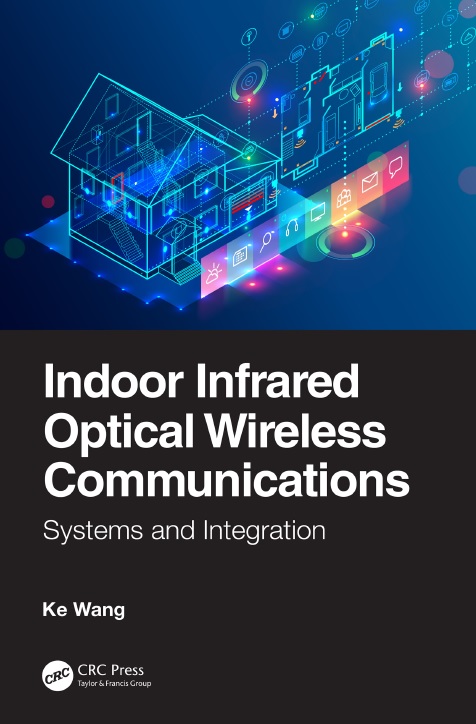by Ke Wang

Contents
Author………………………………………………………………………………………………………..xi
1. Introduction: Optical Wireless Communications……………………………….1
1.1 Optical Wireless Communication Technologies……………………………2
1.2 Optical Wireless Communications – Brief History……………………….4
1.3 Long-Range Outdoor OWC Systems…………………………………………….6
1.4 Short-Range OWC Systems………………………………………………………… 10
1.4.1 Personal and Local Area Networks…………………………………. 10
1.4.2 Wireless Body Area Networks and Indoor Localizations…….14
1.4.3 Optical Interconnects………………………………………………………. 16
1.5 Book Structure…………………………………………………………………………… 19
References………………………………………………………………………………………….. 21
2. Near-Infrared Indoor Optical Wireless Communications:
System Architecture, Principle and Modeling………………………………….27
2.1 Near-Infrared Indoor OWC System Architecture……………………….27
2.1.1 Direct LOS Link-Based Indoor OWC Systems………………….29
2.1.2 Diffusive Link-Based Indoor OWC Systems……………………..30
2.2 Near-Infrared Indoor OWC System Modeling…………………………….33
2.2.1 OWC Transmitter……………………………………………………………..34
2.2.2 OWC Receiver………………………………………………………………….40
2.2.3 OWC Free-Space Channel………………………………………………..44
2.3 High-Speed Near-Infrared Indoor OWC System Example………….47
2.3.1 High-Speed Near-Infrared Indoor OWC System
Structure………………………………………………………………………….47
2.3.2 High-Speed Near-Infrared Indoor OWC System
Operation Principle………………………………………………………….48
2.3.3 High-Speed Near-Infrared Indoor OWC System Model…….50
2.3.4 High-Speed Near-Infrared Indoor OWC System
Simulation and Analysis………………………………………………….54
2.3.5 High-Speed Near-Infrared Indoor OWC System
Demonstration…………………………………………………………………56
2.4 Background Light in Indoor OWC Systems……………………………….. 59
2.5 Conclusions……………………………………………………………………………….. 61
References………………………………………………………………………………………….. 62
3. Spatial Diversity Techniques in Near-Infrared Indoor Optical
Wireless Communication (OWC) Systems………………………………………..65
3.1 Spatial Diversity Techniques in Indoor OWC Systems………………..66
3.2 High-Speed Indoor OWC System with Transmitter Diversity……..68
3.2.1 Repetition Coded Indoor OWC System…………………………….68
3.2.2 Space-Time Coded Indoor OWC System………………………….. 70
3.3 Comparison of STBC- and RC-Based High-Speed Indoor
OWC System……………………………………………………………………………….72
3.4 Delay-Tolerant High-Speed Indoor OWC System with
Transmitter Diversity………………………………………………………………….77
3.5 Conclusions………………………………………………………………………………… 81
References…………………………………………………………………………………………..82
4. Wavelength Multiplexing and Multi-User Access in Near-
Infrared Indoor Optical Wireless Communication Systems…………….83
4.1 Indoor OWC Systems with WDM……………………………………………….84
4.2 FDMA-, CDMA- and TDMA-Based Multi-User Access in
Indoor OWC Systems………………………………………………………………….86
4.3 TSC-Based Multi-User Access in Indoor OWC Systems……………….93
4.3.1 Time-Slot-Coding-Based Multi-User Access in Indoor
OWC Systems…………………………………………………………………..93
4.3.2 Adaptive Loading-Based Time-Slot Coding for
Multi-User Access…………………………………………………………….96
4.3.3 TSC Code Misalignment Tolerance…………………………………..98
4.4 Conclusions………………………………………………………………………………. 104
References………………………………………………………………………………………… 105
5. Photonic Integrations of Near-Infrared Indoor Optical Wireless
Communications……………………………………………………………………………… 107
5.1 Introduction of Photonic Integrations……………………………………….. 108
5.2 Silicon Photonic Integrated Passive Devices……………………………… 110
5.2.1 Silicon Waveguides………………………………………………………… 111
5.2.2 Silicon Integrated Polarization Splitter and Rotator……….. 113
5.2.3 Silicon Integrated Optical Filters……………………………………. 116
5.2.4 Silicon Integrated Optical Power Splitters……………………… 117
5.3 Silicon Photonic Integrated Active Devices………………………………. 119
5.3.1 Silicon Integrated Optical Modulators……………………………. 119
5.3.2 Silicon Integrated Photodetectors…………………………………… 123
5.4 Silicon Photonic Integrations for Indoor OWC Systems……………. 125
5.4.1 Beam Steering Devices in Indoor OWC Systems……………. 125
5.4.2 Optical Phased Arrays for Beam Steering………………………. 127
5.4.3 Silicon Integrated Optical Phased Arrays………………………. 130
5.5 Demonstration of Indoor OWC System with Silicon Photonic
Integrated Circuit……………………………………………………………………… 134
5.6 Conclusions………………………………………………………………………………. 141
References………………………………………………………………………………………… 142
6. Indoor Optical Wireless Localization Technology…………………………. 147
6.1 Indoor Localization Systems…………………………………………………….. 147
6.2 Indoor Localization Based on the Optical Wireless
Technology – “Search and Scan”………………………………………………. 150
6.3 Indoor Optical Wireless Localization Principles with High
Accuracy…………………………………………………………………………………… 152
6.4 Three-Dimensional Indoor Optical Wireless Localization………… 158
6.5 Conclusions………………………………………………………………………………. 162
References………………………………………………………………………………………… 163
7. Conclusions and Future Directions………………………………………………… 165
7.1 Conclusions………………………………………………………………………………. 165
7.2 Optical Interconnect Application of Near-Infrared Optical
Wireless Technology…………………………………………………………………. 167
7.3 Future Research Needs and Directions…………………………………….. 173
References………………………………………………………………………………………… 178
Index………………………………………………………………………………………………………. 179
Preface
We have witnessed the rapid development of wireless communications in the past couple of decades, and currently 4G (and upcoming 5G) and WiFi technologies are surrounding us to provide high-speed wireless connections. The availability of high-speed wireless networks is changing our daily lives. For example, commuters can now watch streaming videos, check emails, or play online games on buses or trains, and students can access digital library collections and professional software everywhere on campus. With the emerging speed-hungry applications, such as ultra-high-definition video-on-demand, virtual reality, and augmented reality, even higher wireless communication speed is expected by end users. Compared with outdoor scenarios, the wireless speed requirement in indoor environments is typically higher, especially in working and living spaces.
To satisfy the ever-growing wireless communication speed requirement in indoor environments, the optical wireless technology has been explored, where the data is carried by the lightwave and transmitted through the wireless link. One key driver for investigating optical wireless communications is the availability of almost unlimited and unregulated bandwidth, which theoretically enables ultra-high-speed wireless connections. Another key advantage of the optical wireless technology is the immunity to traditional electromagnetic interference (EMI), which becomes more attractive due to the co-existence of a large number of wireless systems nowadays.
Indoor optical wireless communications can explore both the visible light range and the near-infrared wavelength range. The visible light communication (VLC) technology becomes increasingly attractive due to the wide deployment of LEDs in the lighting infrastructure, since the LEDs also serve as the transmitters in VLC. On the other hand, the near-infrared optical wireless communication technology can provide higher modulation bandwidth and wireless channel bandwidth, and hence, it is also highly attractive in the future when higher speed is required. This book focuses on near-infrared indoor optical wireless communication technologies and systems, to provide an introduction of this exciting and rapidly developing field. Specifically, this book starts from the basic theories and models, and then discusses various advanced technologies and recent developments.
Although the near-infrared indoor optical wireless technology has seen rapid development during the recent years, there are still a number of challenges to be further studied. For example, the multi-user access principle needs further development and optimization, since traditional principles lack efficiency due to the ultra-high data rate and the physical limitations in optical wireless systems. Another example is the spatial diversity technique for optical wireless communications, where the use of intensity modulation/ direct detection results in the loss of phase information for spatial gains. Therefore, this book also aims to inspire more interests and further studies in this emerging field.
